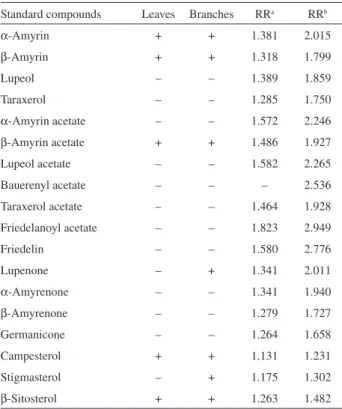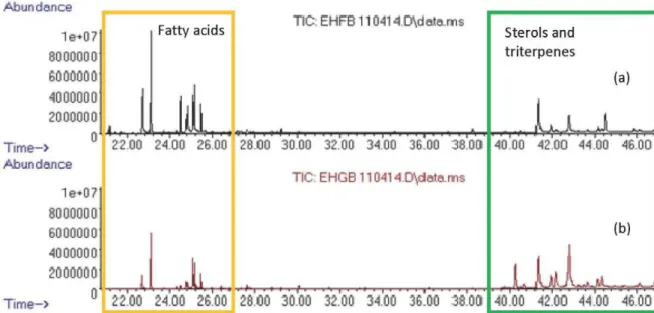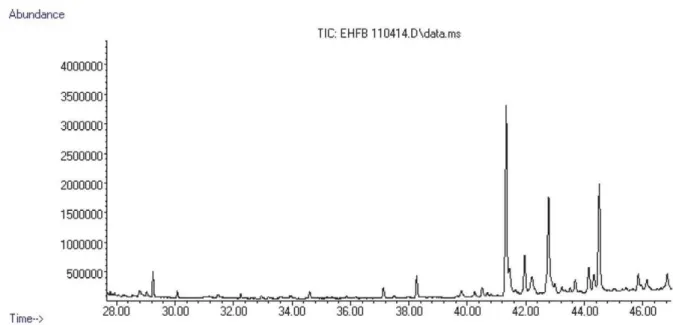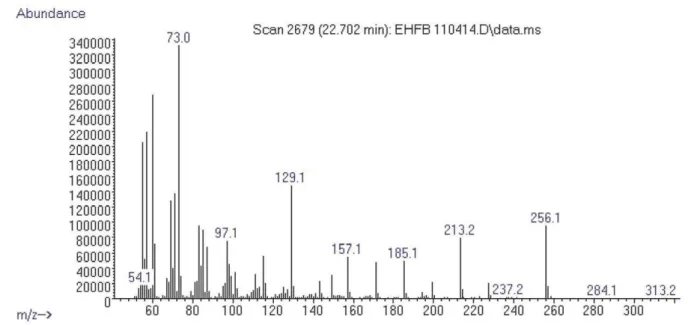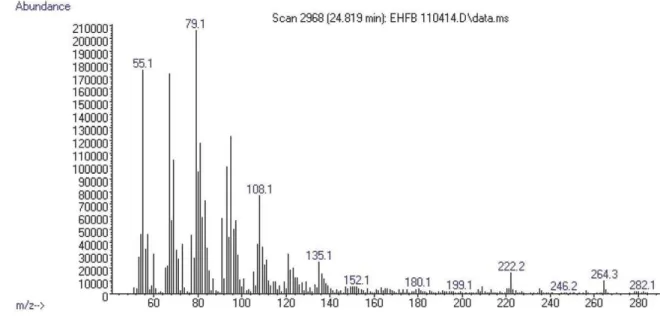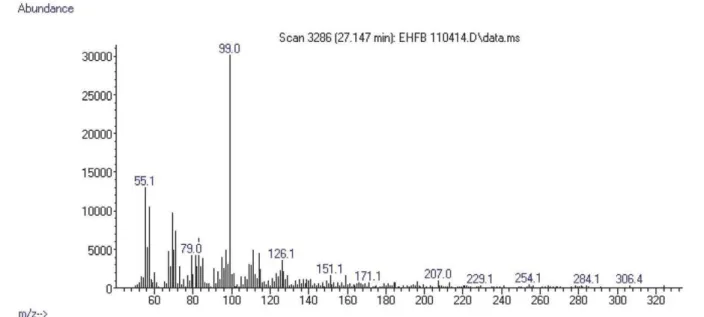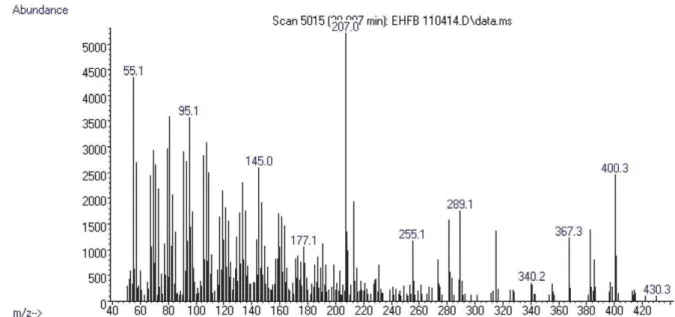Article
J. Braz. Chem. Soc., Vol. 25, No. 10, 1839-1847, 2014. Printed in Brazil - ©2014 Sociedade Brasileira de Química
0103 - 5053 $6.00+0.00
A
http://dx.doi.org/10.5935/0103-5053.20140138
*e-mail: bolzaniv@iq.unesp.br
Leishmanicidal Activity of
Brosimum glaziovii (Moraceae) and Chemical
Composition of the Bioactive Fractions by Using High-Resolution Gas
Chromatography and GC-MS
Aline Coqueiro,a Luis O. Regasini,a Gabriel M. Leme,a Luciana Polese,a Camila T. Nogueira,b Mayara L. Del Cistia,b Marcia A. S. Graminhab and
Vanderlan da S. Bolzani*,a
aInstituto de Química, Universidade Estadual Paulista (Unesp),
CP 355, 14801-970 Araraquara-SP, Brazil
bFaculdade de Ciências Farmacêuticas, Universidade Estadual Paulista (Unesp),
14801-902 Araraquara-SP, Brazil
Dando continuidade às pesquisas de bioprospecção dos programas SisBiota CNPq/FAPESP e Biota-FAPESP, o presente artigo descreve os resultados de atividade leishmanicida e determinação da composição química das frações ativas de Brosimum glaziovii (Moraceae), por meio da cromatografia gasosa. Os extratos e frações das folhas e galhos foram testados in vitro em cepas de
Leishmania amazonensis. As frações hexânicas das folhas e galhos apresentaram atividades potente e moderada, respectivamente (IC50 = 3,6 e 39,1 µg mL-1). Por meio das análises de cromatografia gasosa foi possível identificar os esteróis: campesterol, β-sitosterol e estigmasterol e os triterpenos:
α-amirina, β-amirina, acetato de β-amirina, e lupenona, além de outros constituintes apolares principalmente ácidos graxos e seus derivados. Este é o primeiro trabalho descrito sobre a atividade leishmanicida e composição química desta espécie.
As part of our ongoing SisBiota CNPq/FAPESP and Biota-FAPESP bioprospecting programs, this paper deals with the leishmanicidal properties of Brosimum glaziovii (Moraceae), and used gas chromatography analysis to determine the chemical composition of these fractions. The extracts and fractions from the leaves and branches of B. glaziovii were screened against
Leishmania amazonensis. The hexane fractions from the leaves and branches displayed the highest leishmanicidal activities, with IC50 = 3.6 and 39.1 µg mL
-1. Using gas chromatography analysis it was possible to identify the sterols campesterol, stigmasterol, and β-sitosterol, as well as the triterpenes α-amyrin, β-amyrin, β-amyrin acetate, and lupenone, and other nonpolar components, mainly fatty acids and their derivatives. This is the first report on the leishmanicidal activity and the chemical composition of B. glaziovii.
Keywords:Brosimum glaziovii,leishmanicidal, sterol, triterpene, gas chromatography
Introduction
Neglected tropical diseases (NTDs) are a pathologically diverse group of infections caused by a variety of pathogens, such as viruses, bacteria, protozoa, and helminthes. According to the World Health Organization (WHO), 17 neglected tropical diseases exist. They are endemic in 149 countries and affect more than 1 billion people worldwide.1 The tropical and subtropical regions of
the globe concentrate the main countries with the lowest
human development index (HDI) and the highest NTDs burden.2
Brazil ranks as the 70th country in terms of HDI; nine
of the 10 major NTDs occur in this country. Leishmaniasis, tuberculosis, dengue, and leprosy exist in almost all the Brazilian regions. Most cases arise in poor regions, being the northern and northeastern Brazilian regions the most affected.2
Leishmanicidal Activity of Brosimumglaziovii (Moraceae) and Chemical Composition J. Braz. Chem. Soc. 1840
human immunodeficiency virus (HIV) pandemic has contributed to raising the number of leishmaniasis cases in endemic areas.4 In Brazil, more than 26,000 cases of
cutaneous leishmaniasis (CL) emerged between 1988 and 2009;5 more than 70,000 cases of visceral leishmaniasis
(VL) arose between 1980 and 2008, with 3,800 deaths.6
Currently, leishmaniasis treatment relies on chemotherapy, which poses limitations such as toxicity, difficult administration route, and lack of efficacy in endemic areas. Despite the efforts devoted to finding new drugs that can fight against Leishmania spp., leishmaniasis treatment still depends on the use of pentavalent antimonials (sodium stibogluconate and meglumine antimoniate), first developed over 60 years ago. Unfortunately, the emergence of resistant strains has limited the usefulness of these antimonials. Amphotericin B (and its liposomal formulation, Ambisome), pentamidine isethionate, miltefosine, and paromomycin constitute alternative medications, but their toxicity and high prices have limited their use.7
Brazilian biodiversity is among the richest in the world. Indeed, Brazil is home to many plant species with unknown potential. These plants could find appplication in the search for natural products to treat health problems, like NTDs.
Plants belonging to the family Moraceae - Cecropia pachystachya Mart.,8 Ficus mucusa,9 and
Pourouma guianensis,10 among others, possess antiprotozoal
activities. In particular, Brosimum glaziovii (Moraceae) is endemic in Brazil, but habitat loss threatens this species. The absence of reports on the chemical composition and biological potential of this plant has motivated the phytochemical and biological investigation that is the subject of this article.
To our knowledge, only three species of the same genus as B. glaziovii have been phytochemically examined: B. gaudichaudii, whose roots contain coumarins, chalcones, cinnamic and dihydrocinnamic acid derivatives, triterpenes, and sterols;11-13B. acutifolium, which possesses flavonoids
and lignoids;14-18 and B. rubescens Taubert, whose
heartwood accumulates coumarins.19
As part of the SisBiota CNPq/FAPESP and Biota-FAPESP biodiscovery programs, which aim to search for new hits and lead compounds from the Brazilian flora, this study evaluated the leishmanicidal activity of Brozimum glaziovii (Moraceae) and used high-resolution gas chromatography (HRGC) and gas chromatography-mass spectrometry (GC-MS) to analyze the chemical composition of the bioactive extracts. HRGC constitutes a promising tool to identify the chemical profile of complex nonpolar extracts and fractions. It is an alternative
methodology to aid the construction of the inventory and the characterization of the biodiversity of São Paulo state, which should be useful when exploring mechanisms for its conservation and sustainable use.
Experimental
Plant material
The leaves and branches of Brosimum glaziovii were collected from the Botanic Garden of São Paulo (São Paulo, Brazil) in October 2006 and identified by Dr Inês Cordeiro (IBt-SMA). A voucher specimen (col. S. Romaniuc Neto 1298) was deposited at the State Herbarium “Maria Eneida P. Kaufman” of the Institute of Botany (São Paulo, Brazil).
Preparation of the extracts
Air-dried and powdered leaves (0.85 kg) and branches (2.5 kg) were exhaustively extracted by maceration with ethanol at room temperature. After filtration, the solvent was evaporated at low temperature (< 40 °C) and under reduced pressure, to yield the crude extract from the leaves (35.3 g) and branches (57.3 g). Part of the crude extract from the leaves (10 g) and branches (17 g) was dispersed in water/ methanol 4:1 (600 mL) and successively partitioned with hexane (200 mL, 3×), ethyl acetate (200 mL, 3×), and n-butanol (200 mL, 3×), to afford four fractions from the leaves, namely the hexane (1.5 g), ethyl acetate (1.2 g), n-butanol (0.5 g), and the lyophilized aqueous methanol (0.7 g) fractions, as well as four fractions from the branches - the hexane (2.5 g), ethyl acetate (6.1 g), n-butanol (2.1 g), and the lyophilized aqueous methanol (2.2 g) fractions. Samples of the ethanol extracts and of the hexane, ethyl acetate, n-butanol, and the lyophilized aqueous methanol fractions were further assayed for their leishmanicidal action. The hexane fractions were analyzed by gas chromatography coupled to a flame ionization detector (GC-FID) and gas chromatography-mass spectrometry (GC-MS).
Sample cleanup for HRGC analysis (GC-FID)
Coqueiro et al. 1841 Vol. 25, No. 10, 2014
GC-FID conditions
The hexane fractions were analyzed by HRGC on a Varian model CP-3800 gas chromatograph equipped with split injector [initial splitless; 0.75 min (1:50); 2.00 min (1:20)] at 260 ºC. The flame ionization detector was set at 310 and 290 ºC for the SPB-5 and SPB-50 columns, respectively. The injected volume was 2.0 µL. SPB-50 (cross-linked 50% phenylmethylsiloxane, 30 m × 0.25 mm × 0.25 µm) and SPB-5 (cross-linked 5% phenylmethylsiloxan 30 m × 0.25 mm × 0.25 µm) capillary columns were employed. In the case of SPB-50, the column temperature was 280 ºC (isotherm). For SPB-5, a column temperature program was used - the initial temperature was 250 ºC, maintained for 12 min, followed by a temperature rise to 280 ºC at 6 ºC min-1. Then, the temperature was kept
at 280 ºC for additional 30 min. Nitrogen was employed as the carrier gas at an average linear velocity of 1 mL min-1.
The triterpenes and sterols were identified by comparison of the relative retention (RR) of the samples with the RR of authentic standards. Cholesterol was used as internal standard.
Authentic triterpene and sterol standards
The triterpenes and sterols used as standards were previously isolated from Lauraceae and Rubiaceae species, including Alibertia macrophylla, A. sessilis, Licariarodriguesii, L.subbulata, and Anibaparviflora. The molecular structures of these compounds were identified by the 1H and 13C nuclear magnetic resonance (NMR) and
the MS techniques.20,21
GC-MS conditions
Coupled gas chromatography-mass spectrometry (GC-MS) analysis was performed on an Agilent Technologies 7890A gas chromatograph coupled to a 5975C mass selective detector (Agilent Technologies) under the following instrumental conditions: DB-5 capillary column (cross-linked 5% diphenyl/95% dimethyl polysiloxane, 30 m × 0.25 mm × 0.25 µm, Agilent Technologies Inc., USA). Helium was used as the carrier gas at a flow rate of 1.00 mL min-1. The injection volume was 1 µL; the split
ratio was 20:1. The oven temperature was increased to 50 °C and held at this temperature for 2 min. Then, the temperature was raised to 250 °C at a rate of 8 °C min-1,
to 300 ºC at a rate of 3 °C min-1, and to 310 °C at a rate
of 3 °C min-1. The total run time was 47 min. The mass
spectra were obtained by electron ionization (EI) at 70 eV. All registered peaks were identified by comparison of the mass spectra with those available in the NIST library.
Parasite cultures
Promastigotes of the Leishmania amazonensis MPRO/ BR/1972/M1841-LV-79 strain were maintained at 28 ºC in liver-infusion tryptose medium (LIT) supplemented with 10% heat-inactivated fetal calf serum (FCS). LIT medium was prepared by mixing 10 mg mL-1 hemin (bovine, type I)
(1 mL) with a solution containing NaCl (4.0 g), KCl (0.4 g), Na2PO4 (8.0 g), glucose (2.0 g), liver infusion broth (5.0 g),
and tryptose (5.0 g) at pH 7.0 (900 mL).
Evaluation of the leishmanicidal activity
An antileishmanial assay using promastigote forms of the Leishmania amazonensis MPRO/BR/1972/ M1841-LV-79 strain was performed by employing the 3-(4,5-dimethylthiazol-2-yl)-2,5-diphenyltetrasodium bromide (MTT) colorimetric method described by Santos et al.22 At the end of the exponential growth phase
(4-day-old culture forms), the cultured promastigotes were seeded in 96-well microplates at 8 × 106 parasites mL-1.
The B. glaziovii extracts and fractions were dissolved in dimethyl sulfoxide (DMSO; the highest concentration was 1.4%, which was not hazardous to the parasites, as assessed previously), added to the parasite suspension to final concentrations between 1.6 and 100 µg mL-1,
and incubated at 28 ºC for 72 h. The assays were carried out in triplicate. The reference drug was pentamidine isethionate purchased from Sigma-Aldrich (St Louis, MO, USA). To this end, a 16.7 mg mL-1 stock solution
of the reference drug was prepared in sterile deionized water and added to the parasite suspension, to obtain final pentamidine isethionate concentrations between 1.6 and 100 µg mL-1. Leishmanicidal effects were assessed by
the MTT method with modifications.22 The 50% mean
inhibitory concentration (IC50) of the tested compounds
and the positive control were determined by calculating the percentage of cytotoxicity.
Evaluation of the cytotoxicity on J774 macrophages
To evaluate the cytotoxicity of the B. glaziovii extracts and fractions on J774 macrophage lineages, the latter cells were grown in 25 cm2 culture flasks containing 5 mL
of Roswell Park Memorial Institute (RPMI) medium supplemented with 10% bovine fetal serum, kept in an incubator at 37 °C and 5% CO2 atmosphere, and transferred
Leishmanicidal Activity of Brosimumglaziovii (Moraceae) and Chemical Composition J. Braz. Chem. Soc. 1842
of Gibco® powder, distilled water, sodium bicarbonate,
Hepes buffer, bovine fetal serum, and antibiotics); the concentration of the cells was set to 1 × 105 cells mL-1.
Cell viability was evaluated by addition of the vital dye trypan blue (0.02%). The cell suspension (200 µL) was distributed in TPP 96-well plates and incubated at 37 °C and 5% CO2 for 24 h. The supernatant was removed from
the plate; then, 97 µL of RPMI and 3 µL of the extracts and fractions that had activity < 100 µg mL-1 were diluted with
sterile water and added in decreasing concentrations (250 to 1.5 µg mL-1), in triplicate. Next, the cells were incubated
at 37 °C and 5% CO2 for 24 h. Pentamidine was used as the
reference drug. After incubation, 10 µL of MTT/phenazine methosulfate (PMS) solution was added, and the cells were incubated at 37 °C and 5% CO2 for 75 min. Then, 100 µL
of sodium dodecyl sulfate (SDS) was added, which was followed by incubation at room temperature for 30 min. The absorbance at 540 nm was measured in a microplate reader (Elisa reader, Readwell Touch/Robonik). The results were expressed in LC50 (lethal concentration that killed
50% of the cells).
The selectivity index (SI), an important characteristic to define hit compounds, was calculated by dividing the values obtained for the cytotoxic activity against macrophages J774 by the results achieved during leishmanicidal actions (SI = LC50 / IC50) for the most active extracts and fractions.
Results and Discussion
To expand the current knowledge about the plants of the Moraceae family, in this work we evaluated the antileishmanial potential of extracts and fractions from the leaves and branches of B. glaziovii (Moraceae) and investigated the chemical profile of the active fractions
by high-resolution gas chromatography (HRGC) and gas chromatography-mass spectrometry (GC-MS). Antileishmanial assays of the extracts and fractions from the leaves and branches of B. glaziovii against the promastigote form of L. amazonensis helped us to achieve our goals. Table 1 summarizes the main results.
Among all the tested fractions and extracts, the nonpolar hexane fraction from the leaves of B. glaziovii displayed the highest activity against L. amazonensis, with IC50 of
3.6 ± 0.34 µg mL-1. This result was close to that obtained with
the positive control pentamidine (IC50 = 4.0 ± 0.26 µg mL-1),
the drug of choice to treat cutaneous leishmaniasis in South America.23 The activity of the hexane fraction from the leaves
of B. glaziovii was higher than that of the corresponding ethanol extract (IC50 = 82.9 ± 0.48 µg mL-1). This evidenced
that fractionation potentiated the activity by concentrating the most active compound(s) in the hexane fraction. The ethyl acetate fraction from the leaves of B. glaziovii had lower biological activity than the hexane fraction (51.8 ± 2.26 µg mL-1). Nevertheless, these data indicated
that B. glaziovii contains antileishmanial compounds with different polarities.
As for the leishmanicidal action of the branches of B. glaziovii, fractionation also potentiated the activity, as verified by comparison of the activities of the hexane and ethyl acetate fractions (IC50 = 39.1 ± 1.15 and
48.7 ± 1.87 µg mL-1, respectively) with that of the crude
ethanol extract (IC50 > 100 µg mL
-1), considered inactive.
Hence, the branches of B. glaziovii also presented leishmanicidal activity, albeit almost 10-fold lower than the leaves.
Regarding cytotoxicity evaluation, we calculated the selectivity index (SI), a relevant characteristic to define hit compounds, for the ethanol extracts and the hexane
Table 1. Leishmanicidal and cytotoxic activities of the extracts and fractions from B. glaziovii in µg mL-1
Extracts and fractions Antiprotozoal activity (IC50) Cytotoxicity (LC50) Selectivity index (SI) Leishmania amazonensis Macrophage JJ74
Leaves
Ethanol 82.9 ± 0.48 266.50 ± 4.95 3.21
Hexane 3.6 ± 0.34 129.25 ± 1.06 35.90
Ethyl acetate 51.8 ± 2.26 200.75 ± 7.42 3.87
n-Butanol > 100 – –
Aqueous methanol > 100 – –
Branches
Ethanol > 100 – –
Hexane 39.1 ± 1.15 127.25 ± 1.06 3.25
Ethyl acetate 48.7 ± 1.87 200.50 ± 2.12 4.12
n-Butanol > 100 – –
Aqueous methanol > 100 – –
Pentamidinea 4 ± 0.26 7.5 ± 0.35 1.87
Coqueiro et al. 1843 Vol. 25, No. 10, 2014
and ethyl acetate fractions from the leaves and branches of B. glaziovii. To this end, we divided the cytotoxic activity of the extract or fraction against J774 macrophages (LC50) by its leishmanicidal activity (SI = LC50 / IC50).
We employed macrophages to determine SI, because they are the main host cells for Leishmania (Table 1). Using the LC50 value of 129.3 µg mL-1 found for J774
macrophages treated with the hexane fraction from the leaves of B. glaziovii (which was the most active fraction), we calculated an SI of 35.9 for L. amazonensis, which is almost twenty times higher than that of the control drug pentamidine (SI = 1.9, Table 1). Therefore, this fraction possesses good selectivity for L. amazonensis promastigote forms rather than macrophages. The SI values determined for the other active extracts and fractions (ethanol extract and ethyl acetate fraction from the leaves and the hexane and ethyl acetate fractions from the branches) indicated that they were less selective than the hexane fraction from the leaves, but they still were twice more selective for the parasite than the control drug pentamidine (SI = 1.9). Hence, these extracts and fractions are also attractive for further chemical characterization.
The biological activities of nonpolar extracts have often been attributed to complex mixtures of triterpenoid and/or steroid compounds.24,25
Gas chromatography coupled with mass spectrometry (GC-MS) is the most powerful technique to characterize nonpolar compounds in a mixture, so it constitutes an alternative to the preliminary screening of complex plant extracts. However, this hyphenated analytical technique is still inaccessible to many research groups. On the other hand, GC-FID analysis is rapid, simple, relatively cheap, and more readily available, so it is potentially applicable as a preliminary procedure.21
Aiming to identify the steroids and triterpenes present in the most active fractions from the leaves and branches of B. glaziovii, we used high-resolution gas chromatography (HRGC), a fast method that does not require pre-derivatization. The GC-FID method we employed in this study involved two different columns: SPB-5 and SPB-50. The low polarity, inertness toward organic compounds, and high temperature limit of these columns make them ideal for analysis of underivatized semi-volatile plant extracts.
By using the SPB-5 and SPB-50 columns to analyze the hexane fraction from the leaves of B. glaziovii, it was possible to obtain chromatograms with well-resolved peaks, which enabled proper identification of some components by RR values and comparison of these values with those of authentic samples (Figures 1A, 1B, 1C, and 1D). The RR values were calculated by dividing the retention time
Figure 1. Gas chromatogram (HRGC) of B. glaziovii. (A) Leaves; SPB-5 column [IS: internal standard (cholesterol) (tR = 18.60 min); (1) campesterol
(tR = 20.95 min); (2) β-sitosterol (tR = 23.35 min); (3) β-amyrin (tR = 24.32 min), (4) α-amyrin (tR = 25.51 min), and (5) β-amyrin acetate (tR = 27.53 min)]. (B) Leaves; SPB-50 column [IS: internal standard (cholesterol) (tR = 13.06 min); (1) campesterol (tR = 16.19 min); (2) β-sitosterol (tR = 19.09 min); (3) β-amyrin (tR = 23.26 min), (5) β-amyrin acetate (tR = 25.22 min), and (4) α-amyrin (tR = 26.22 min)]. (C) Branches; SPB-5 column [IS: internal
standard (cholesterol) (tR = 18.53 min); (1) campesterol (tR = 20.90 min); (6) stigmasterol (tR = 21.75 min); (2) β-sitosterol (tR = 23.35 min); (3) β-amyrin (tR = 24.33 min); (7) lupenone (tR = 24.92 min); (4) α-amyrin (tR = 25.56 mim), and (5) β-amyrin acetate (tR = 27.50 min)]. (D) Branches; SPB-50 column
Leishmanicidal Activity of Brosimumglaziovii (Moraceae) and Chemical Composition J. Braz. Chem. Soc. 1844
(tR) of the compound by the retention time of the standard
for both columns. Co-injection with authentic standards additionally confirmed the presence of each triterpene or sterol and avoided misclassifications due to overlapping of the retention zones.
The HRGC results (Table 2) attested to the major occurrence of the sterols campesterol (1), and β-sitosterol (2)and of the triterpenes β-amyrin (3), α-amyrin (4) and β-amyrin acetate (5) in the hexane fractions from the leaves and branches of B. glaziovii; besides these the sterol stigmasterol (6), and the pentacyclic triterpene lupenone (7) were also present in the hexane fraction from the branches of B. glaziovii.
The mixture of α/β-amyrin triterpenes exists in many medicinal plants and accounts for many bioactive properties, including analgesic, antimicrobial, and anti-inflammatory actions.26 These compounds can underlie the
activity exhibited by the hexane fractions from B. glaziovii. Interestingly, although these substances occur in the hexane fractions from both the leaves and branches, the fraction from the leaves showed stronger activity, suggesting that other compounds also contribute to the antileishmanial properties.
To prove the identity of the substances identified by GC-FID (by comparison with the authentic compounds) and to obtain the full profile of the hexane fractions from the leaves and branches of B. glaziovii, we also performed the GC-MS analysis for the hexane fractions (Supplementary Information). We identified the substances on the basis of the NIST library and by comparison with literature data. Only the compounds with 90% of similarities with the database or higher than that were taken into account for our analysis. The GC-MS analysis of the hexane fractions of leaves and branches are given in the Table 3. Besides the confirmation of the triterpenes and sterols previously identified by HRGC, the GC-MS allowed us to detect a further series of compounds constituted mainly of long chain fatty acids and its derivatives.
The hexane fraction of leaves mainly contains palmitic acid (n-hexadecanoic acid) and its derivative (hexadecanoic acid, ethyl esther); stearic acid derivatives [(12-octadecadienoic acid (Z,Z)-; 9,12,15-octadecatrienoic acid, (Z,Z,Z)-] and octadecanoic acid, ethyl ester); linoleic acid, ethyl ester and the diterpene alcohol-phytol. For the hexane fraction of branches the most abundant fatty acids were the palmitic acid derivative (hexadecanoic acid, ethyl esther); the stearic acid derivatives [(octadecanoic acid, ethyl ester and 9,12,15-octadecatrienoic acid, (Z,Z,Z)-] and linoleic acid, ethyl ester. Some fatty acids, like palmitic acid,27 among
others28 have been shown to have antiprotozoal activity.
These results demonstrated that, despite the similarities between the hexane fractions from the leaves and branches of B. glaziovii, these fractions exhibited different chemical profiles and antileishmanial activity. Taken together, these findings corroborated that plant tissues produce compounds in different ways, which can be relevant when considering the chemical interface between plants and the surrounding environment.29
The preliminary phytochemical screening by HRGC proved to be a useful tool to identify secondary metabolites, in this case, the triterpenes and sterols presented in complex extracts and fractions of B. glaziovii, in special the bioactive hexane fraction, which the chemical profile was successfully mapped (Figure 2).
Further bio-guided studies regarding the isolation and antileishmanial evaluation of the pure compounds are necessary to identify the bioactive compounds or a possible synergism between the molecules present in the active fractions of B. glaziovii.
Conclusions
Neglected tropical diseases are a recognized public health concern affecting mostly the impoverished regions of Table 2. Chemical composition of the hexane fractions from the leaves
and branches of B. glaziovii as assessed by HRGC analysis (SPB-5 and SPB-50 columns)
Standard compounds Leaves Branches RRa RRb
α-Amyrin + + 1.381 2.015
β-Amyrin + + 1.318 1.799
Lupeol – – 1.389 1.859
Taraxerol – – 1.285 1.750
α-Amyrin acetate – – 1.572 2.246
β-Amyrin acetate + + 1.486 1.927
Lupeol acetate – – 1.582 2.265
Bauerenyl acetate – – – 2.536
Taraxerol acetate – – 1.464 1.928
Friedelanoyl acetate – – 1.823 2.949
Friedelin – – 1.580 2.776
Lupenone – + 1.341 2.011
α-Amyrenone – – 1.341 1.940
β-Amyrenone – – 1.279 1.727
Germanicone – – 1.264 1.658
Campesterol + + 1.131 1.231
Stigmasterol – + 1.175 1.302
β-Sitosterol + + 1.263 1.482
aSPB-5 column; bSPB-50 column. RR: relative retention related to the
Coqueiro et al. 1845 Vol. 25, No. 10, 2014
the world. In the American continent, Brazil is the country that is most impacted by leishmaniasis. This country also relies on wide biodiversity, which constitutes a superb source of chemical diversity. By using rational screening, it is possible to identify hits and leads that will be essential for further research into the development of potential drugs. The chemical and pharmacological potential of many plants remains unexplored. HRGC proved to be a rapid, simple, and relatively cheap preliminary screening tool to
characterize plant mixtures in a reliable way. This technique enabled the identification of some triterpenes and sterols present in the bioactive extracts from Brosimum glaziovii, traced as campesterol (1), β-sitosterol (2), β-amyrin (3), α-amyrin (4), β-amyrin acetate (5), stigmasterol (6) and lupenone (7). Although the identified metabolites have been known for some time, this is the first time that their presence has been detected in the species B. glaziovii. The GC-MS analysis allowed the confirmation of the substances Table 3. Compounds identified in the hexane fractions from the leaves and branches of B. glaziovii using gas chromatography coupled with electron ionization mass spectrometry (GC-MS)
Compounds Molecular formula Molecular weight Leaves Branches
Phenol, 4,4’-(1-methylethylidene)bis-; 95a; 95b C
15H16O2 228 X X
n-Hexadecanoic acid; 99a; 99b C
16H32O2 256 X X
Tetradecanoic acid, ethyl ester; 90b C
16H32O2 256 – X
Cyclohexene, 4-(4-ethylcyclohexyl)-1-pentyl-; 95b C
19H34 262 – X
2-Pentadecanone, 6,10,14-trimethyl-; 91a C
18H36O 268 X –
Pentadecanoic acid, ethyl ester; 99b C
17H34O2 270 – X
Hexadecanoic acid, methyl ester; 98b C
17H34O2 270 – X
Dibutyl phthalate; 90b C
16H22O4 278 – X
9,12,15-Octadecatrienoic acid, (Z,Z,Z)-; 99ª; 96b C
18H30O2 278 X X
1,2-Benzenedicarboxylic acid, mono(2-ethylhexyl) ester; 91a; 90b C
16H22O4 278 X X
9,12-Octadecadienoic acid (Z,Z)-; 99ª; 99b C
18H32O2 280 X X
12-Methyl-E,E-2,13-octadecadien-1-ol; 93a C
19H36O 280 X –
Cyclopropaneoctanal, 2-octyl-; 97b C
19H36O 280 – X
2-Methyl-Z,Z-3,13-octadecadienol; 91a C
19H36O 280 X –
Ethyl 9-hexadecenoate; 95ª; 99b C
18H34O2 282 X X
Hexadecanoic acid, ethyl ester; 99a; 98b C
18H36O2 284 X X
Phytol; 91a; 95b C
20H40O 296 X X
Heptadecanoic acid, ethyl ester; 98a; 99b C
19H38O2 298 X X
9,12,15-Octadecatrienoic acid, ethyl ester, (Z,Z,Z)-; 99ª; 99b C
20H34O2 306 X X
Linoleic acid, ethyl ester; 99ª; 99b C
20H36O2 308 X X
Ethyl oleate; 98b C
20H38O2 310 – X
Octadecanoic acid, ethyl ester; 99a; 99b C
20H40O2 312 X X
4,8,12,16-Tetramethylheptadecan-4-olide; 93a C
21H40O2 324 X –
Nonadecanoic acid, ethyl ester; 93ª; 96b C
21H42O2 326 X X
Nonadecanoic acid, ethyl ester; 95b C
21H42O2 326 – X
Cyclodocosane, ethyl-; 96a C
24H48 336 X X
4,4,6a,6b,8a,11,12,14b-Octamethyl-1,4,4a,5,6,6a,6b,7,8,8a,9,10,11,12,12a,14, 14a,14b-octadecahydro-2H-picen-3-one; 99a
C30H48O 424 X –
Fern-7-en-3β-ol; 90a C
30H50O 426 X –
Vitamin E; 99a C
29H50O2 430 X –
Ethyl tetracosanoate; 95b C
26H52O2 396 – X
Squalene; 99b C
30H50 410 – X
Lanosterol; 93b C
30H50O 426 – X
Leishmanicidal Activity of Brosimumglaziovii (Moraceae) and Chemical Composition J. Braz. Chem. Soc. 1846
Figure 2. Structures of the triterpenes (3-5 and 7) and the sterols (1-2 and 6) present in B. glaziovii.
identified by HRGC and the identification of the major constituents of the bioactive fractions, including some long chain fatty acids and their derivatives.
This study demonstrated the strong leishmanicidal activity of the hexane fraction from the leaves of B. glaziovii (IC50 = 3.6 µg mL
-1) against the L. amazonensis strain
as well as its low cytotoxicity (IC50 = 129.3 µg mL-1)
against macrophage J774 as compared with the control drug pentamidine (which has well-known strong activity, IC50 = 4.0 µg mL
-1, but high toxicity, IC
50 = 7.5 µg mL -1).
Also, the composition of the active fraction showed that B. glaziovii is a potential source of leishmanicidal compounds for further pharmacological and toxicological studies.
Supplementary Information
Supplementary information (Figures S1-S65) is available free of charge at http://jbcs.sbq.org.br as PDF file.
Acknowledgements
This work was funded by grants 06/61187-7 from the São Paulo Research Foundation (FAPESP) as part of the Biota-FAPESP program grant 2010/52327-5. We also acknowledge CNPq, CAPES, and FAPESP for researcher and student fellowships. The authors would like to thank Dr Maria Claudia Marx Young of Instituto de Botânica (São Paulo, SP, Brazil) for kindly providing us the plant material and Dr Young Hae Choi and Prof Robert Verpoorte of the Natural Products Laboratory at the Institute of Biology of Leiden University (Leiden, The Netherlands) for providing the GC-MS facilities.
References
1. http://www.who.int/neglected_diseases/about/en/ accessed in May 2014.
2. Lindoso, J. A. L.; Lindoso, A. B. P.; Rev. Inst. Med. Trop. São Paulo 2009, 51, 247.
3. World Health Organization (WHO); Working to Overcome the Global Impact of NTDs: First WHO Report on NTDs; WHO: Geneva, 2010, p. 172.
4. Alvar, J.; Aparicio, P.; Aseffa, A.; Den Boer, M.; Canavate, C.; Dedet, J. P.; Gradoni, L.; Ter Horst, R.; Lopez-Velez, R.; Moreno, J.; Clin. Microbiol. Rev. 2008, 21, 334.
5. http://portal.saude.gov.br/portal/saude/visualizar_texto. cfm?idtxt=22141 accessed in May 2014.
6. Werneck, G. L.; Cad. Saúde Pública 2010, 26, 644. 7. Chawla, B.; Madhubala, R.; J. Parasit. Dis. 2010, 34, 1. 8. Muelas-Serrano, S.; Nogal, J. J.; Matínez-Díaz, R. A.;
Escario, J. A.; Matínez-Fernández, A. R.; Gómez-Barrio, A.; J. Ethnopharmacol. 2000, 71, 101.
9. Bankeu, J. J. K.; Khayala, R.; Lenta, B. N.; Noungoué, D. T.; Ngoula, S. A.; Asaad, M. K.; Choudhary, M. I.; Prigge, S. T.; Hasanov, R.; Nkengfack, A. E.; Tsamo, E.; Ali, M. S.; J. Nat. Prod. 2011, 74, 1370.
10. Torres-Santos, E. C.; Lopes, D.; Oliveira, R. R.; Carauta, J. P. P.; Falcao, C. A. B.; Kaplan, M. A. C.; Rossi-Bergmann, B.; Phytomedicine 2004, 11, 114.
11. Monteiro, V. F. F.; Mathias, L.; Vieira, I. J. C.; Schripsema, J.; Braz-Filho, R.; J. Braz. Chem. Soc. 2002, 13, 281.
12. Pozetti, G. L.; Vilegas, W.; J. Nat. Prod. 1993, 56, 416. 13. Vilegas, W.; Pozetti, G. L.; Vilegas, J. H. Y.; J. Nat. Prod. 1993,
56, 416.
14. Torres, S. L.; Monteiro, J. C. M.; Arruda, M. S. P.; Müller, A. H.; Arruda, A. C.; Phytochemistry 1996, 44, 347.
15. Torres, S. L.; Arruda, M. S. P.; Arruda, A. C.; Müller, A. H.; Silva, S. C.; Phytochemistry 2000, 53, 10.
16. Takashima, J.; Ohsaki, A.; J. Nat. Prod. 2002, 65, 1843. 17. Takashima, J.; Asano, S.; Ohsaki, A.; Planta Med. 2002, 68,
621.
18. Takashima, J.; Komiyama, K.; Ishiyama, H.; Kobayashi, J.; Ohsaki, A.; Planta Med. 2005, 71, 654.
19. Filho, R. B.; Magalhães, A. F.; Gottlieb, O. R.; Phytochemistry 1972, 11, 3307.
20. Silva, V. C.; Faria, A. O.; Bolzani, V. S.; Lopes, M. N.; Helv. Chim. Acta 2007, 90, 1781.
21. Regasini, L. O.; Vieira-Júnior, G. M.; Fernandes, D. C.; Bolzani, V. S.; Cavalheiro, A. J.; Silva, D. H. S.; J. Chil. Chem. Soc. 2009, 54, 218.
22. Santos, V. A.; Regasini, L. O.; Nogueira, C. R.; Passerini, G. D.; Martinez, I.; Bolzani, V. S.; Graminha, M. A.; Cicarelli, R. M.; Furlan, M.; J. Nat. Prod. 2012, 75, 991.
Coqueiro et al. 1847 Vol. 25, No. 10, 2014
24. Otuki, M. F.; Ferreira, J.; Lima, F. V.; Meyere-Silva, C.; Malheiros, A.; Muller, A.; Cani, G. S.; Sabtos, A. R. S.; Yunes, R. A.; Calixto, J. B.; J. Pharmacol. Exp. Ther. 2005, 313, 310. 25. Gaertner, M.; Müller, L.; Ross, J. F.; Cani, G.; Santos, A. R. S.;
Niero, R.; Calixto, J. B.; Yunes, R. A.; Delle Monache, F.; Cechinel-Filho, V.; Phytomedicine 1999, 6, 41.
26. Hernández-Vázquez, L.; Mangas, S.; Palazón, J.; Navarro-Ocaña, A.; Ind. Crop. Prod. 2010, 31, 476.
27. Cunningham, B.; Kazan, B. H.; Kuwahara, S. S.; J. Gen. Microbiol. 1972, 70, 491.
28. Carballeira, N. M.; Cartagena, M.; Sanabria, D.; Tasdemir, D.; Prada, C. F.; Reguera, R. M.; Balaña-Fouce, R.; Bioorg. Med. Chem. Lett. 2012, 22, 6185.
29. Gobbo-Neto, I.; Lopes, N. P.; Quim. Nova 2007, 30, 374.
Submitted: February 3, 2014 Published online: June 10, 2014
Supplementary Information
S
I
J. Braz. Chem. Soc., Vol. 25, No. 10, S1-S33, 2014. Printed in Brazil - ©2014 Sociedade Brasileira de Química 0103 - 5053 $6.00+0.00
*e-mail: bolzaniv@iq.unesp.br
Leishmanicidal Activity of
Brosimum glaziovii
(Moraceae) and Chemical
Composition of the Bioactive Fractions by Using High-Resolution Gas
Chromatography and GC-MS
Aline Coqueiro,a Luis O. Regasini,a Gabriel M. Leme,a Luciana Polese,a
Camila T. Nogueira,b Mayara L. Del Cistia,b Marcia A. S. Graminhab and
Vanderlan da S. Bolzani*,a
aInstituto de Química, Universidade Estadual Paulista (Unesp),
CP 355, 14801-970 Araraquara-SP, Brazil
bFaculdade de Ciências Farmacêuticas, Universidade Estadual Paulista (Unesp),
14801-902 Araraquara-SP, Brazil
Leishmanicidal Activity of Brosimumglaziovii (Moraceae) and Chemical Composition J. Braz. Chem. Soc.
S2
Figure S2. Full mass chromatogram obtained for the hexane fraction of leaves of B. glaziovii using GC-MS.
Coqueiro et al. S3 Vol. 25, No. 10, 2014
Figure S4. Expansion of the mass chromatogram (28-47 min) obtained for the hexane fraction of leaves of B. glaziovii using GC-MS.
Leishmanicidal Activity of Brosimumglaziovii (Moraceae) and Chemical Composition J. Braz. Chem. Soc.
S4
Figure S6. Mass spectra obtained for n-hexadecanoic acid (tR = 22.702 min).
Coqueiro et al. S5 Vol. 25, No. 10, 2014
Figure S8. Mass spectra obtained for hexadecanoic acid, ethyl ester (tR = 23.098 min).
Leishmanicidal Activity of Brosimumglaziovii (Moraceae) and Chemical Composition J. Braz. Chem. Soc.
S6
Figure S10. Mass spectra obtained for phytol (tR = 24.489 min).
Coqueiro et al. S7 Vol. 25, No. 10, 2014
Figure S12. Mass spectra obtained for 9,12,15-octadecatrienoic acid, (Z,Z,Z)- (tR = 24.819 min).
Leishmanicidal Activity of Brosimumglaziovii (Moraceae) and Chemical Composition J. Braz. Chem. Soc.
S8
Figure S14. Mass spectra obtained for linoleic acid, ethyl ester (tR = 25.075 min).
Coqueiro et al. S9 Vol. 25, No. 10, 2014
Figure S16. Mass spectra obtained for 2-methyl-Z,Z-3,13-octadecadienol (tR = 25.221 min).
Leishmanicidal Activity of Brosimumglaziovii (Moraceae) and Chemical Composition J. Braz. Chem. Soc.
S10
Figure S18. Mass spectra obtained for octadecanoic acid, ethyl ester (tR = 25.448 min).
Coqueiro et al. S11 Vol. 25, No. 10, 2014
Figure S20. Mass spectra obtained for 4,8,12,16-tetramethylheptadecan-4-olide (tR = 27.147 min).
Leishmanicidal Activity of Brosimumglaziovii (Moraceae) and Chemical Composition J. Braz. Chem. Soc.
S12
Figure S22. Mass spectra obtained for cyclodocosane, ethyl- (tR = 34.601 min).
Coqueiro et al. S13 Vol. 25, No. 10, 2014
Figure S24. Mass spectra obtained for campesterol (tR = 39.807 min).
Leishmanicidal Activity of Brosimumglaziovii (Moraceae) and Chemical Composition J. Braz. Chem. Soc.
S14
Figure S26. Mass spectra obtained for β-amyrin (tR = 41.937 min).
Coqueiro et al. S15 Vol. 25, No. 10, 2014
Figure S28. Mass spectra obtained for α-amyrin (tR = 42.794 min).
Leishmanicidal Activity of Brosimumglaziovii (Moraceae) and Chemical Composition J. Braz. Chem. Soc.
S16
Figure S30. Mass spectra obtained for fern-7-en-3-β-ol (tR = 44.149 min).
Coqueiro et al. S17 Vol. 25, No. 10, 2014
Figure S32. Expansion of the mass chromatogram (20-31 min) obtained for the hexane fraction of branches of B. glaziovii using GC-MS.
Leishmanicidal Activity of Brosimumglaziovii (Moraceae) and Chemical Composition J. Braz. Chem. Soc.
S18
Figure S34. Mass spectra obtained for tetradecanoic acid, ethyl ester (tR = 20.513 min).
Coqueiro et al. S19 Vol. 25, No. 10, 2014
Figure S36. Mass spectra obtained for pentadecanoic acid, ethyl ester (tR = 21.839 min).
Leishmanicidal Activity of Brosimumglaziovii (Moraceae) and Chemical Composition J. Braz. Chem. Soc.
S20
Figure S38. Mass spectra obtained for n-hexadecanoic acid (tR = 22.688 min).
Coqueiro et al. S21 Vol. 25, No. 10, 2014
Figure S40. Mass spectra obtained for hexadecanoic acid, ethyl ester (tR = 23.091 min).
Leishmanicidal Activity of Brosimumglaziovii (Moraceae) and Chemical Composition J. Braz. Chem. Soc.
S22
Figure S42. Mass spectra obtained for phytol (tR = 24.482 min).
Coqueiro et al. S23 Vol. 25, No. 10, 2014
Figure S44. Mass spectra obtained for 9,12,15-octadecatrienoic acid, (Z,Z,Z)- (tR = 24.804 min).
Leishmanicidal Activity of Brosimumglaziovii (Moraceae) and Chemical Composition J. Braz. Chem. Soc.
S24
Figure S46. Mass spectra obtained for 9,12,15-octadecatrienoic acid, ethyl ester, (Z,Z,Z)- (tR = 25.141 min).
Coqueiro et al. S25 Vol. 25, No. 10, 2014
Figure S48. Mass spectra obtained for phenol, 4,4’-(1-methylethylidene)bis- (tR = 25.295 min).
Leishmanicidal Activity of Brosimumglaziovii (Moraceae) and Chemical Composition J. Braz. Chem. Soc.
S26
Figure S50. Mass spectra obtained for nonadecanoic acid, ethyl ester (tR = 26.554 min).
Coqueiro et al. S27 Vol. 25, No. 10, 2014
Figure S52. Mass spectra obtained for cyclohexene, 4-(4-ethylcyclohexyl)-1-pentyl- (tR = 27.206 min).
Leishmanicidal Activity of Brosimumglaziovii (Moraceae) and Chemical Composition J. Braz. Chem. Soc.
S28
Figure S54. Mass spectra obtained for 1,2-benzenedicarboxylic acid, mono(2-ethylhexyl) ester (tR = 29.241 min).
Coqueiro et al. S29 Vol. 25, No. 10, 2014
Figure S56. Mass spectra obtained for ethyl tetracosanoate (tR = 32.939 min).
Leishmanicidal Activity of Brosimumglaziovii (Moraceae) and Chemical Composition J. Braz. Chem. Soc.
S30
Figure S58. Mass spectra obtained for campesterol (tR = 39.799 min).
Coqueiro et al. S31 Vol. 25, No. 10, 2014
Figure S60. Mass spectra obtained for β-sitosterol (tR = 41.330 min).
Leishmanicidal Activity of Brosimumglaziovii (Moraceae) and Chemical Composition J. Braz. Chem. Soc.
S32
Figure S62. Mass spectra obtained for β-amyrin (tR = 41.967 min).
Coqueiro et al. S33 Vol. 25, No. 10, 2014
Figure S64. Mass spectra obtained for α-amyrin (tR = 42.772 min).

